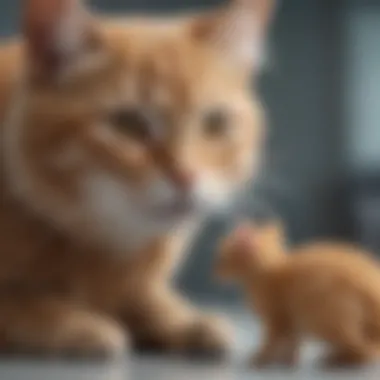Recognizing Symptoms of Cat Urinary Tract Infections


Intro
Cat urinary tract infections (UTIs) are more than just a nuisance. They can lead to serious health issues if not addressed. Understanding the symptoms early is crucial for timely intervention. It ensures that your feline receives the necessary care before a minor problem escalates into something more severe.
Recognizing these signs can be life-saving for your cat. This article aims to equip pet owners with the insights needed to identify potential UTIs. By understanding what to look for, you can take action when it matters most.
Understanding Your Pet
Understanding your cat's unique traits can significantly aid in spotting symptoms of a urinary tract infection. While every cat is distinct, certain breed traits and common temperaments can influence their health and behavior.
Breed Traits
Different cat breeds may exhibit varying susceptibility to UTIs. For instance, Persian cats or Siamese are known to have genetic predispositions affecting their overall health. Recognizing these traits can help owners maintain vigilant observation for any signs of UTI.
Common Temperaments
Cats are often creatures of habit. Behavioral changes could indicate discomfort or pain. For instance, a usually playful cat may suddenly become withdrawn or exhibit signs of aggression. Paying attention to changes in behavior can provide essential clues regarding their health status.
Special Needs
Some cats may have special health considerations requiring closer monitoring. Older cats or those with previous urinary issues are more susceptible to infections. Understanding these needs ensures better proactive care, translating into earlier identification of symptoms.
Pet Care Essentials
Various aspects of cat care can impact their likelihood of developing UTIs. Focusing on nutrition, grooming, and overall wellness can contribute to a healthier life for your pet.
Nutrition and Feeding Guidelines
Proper nutrition plays an essential role in maintaining a cat’s urinary health. High-quality, moisture-rich diets can help prevent crystallization in the urine, a common issue leading to infections.
- Feed balanced cat food with sufficient moisture.
- Ensure fresh water is always available.
- Monitor their eating habits as changes can indicate health issues.
Grooming Tips and Techniques
Regular grooming helps maintain your cat's skin and fur health but also assists in spotting any abnormalities. Using gentle brushes can help remove loose fur or debris, ensuring a clean environment.
Health and Wellness
Routine vet check-ups are vital. Regular screenings can help catch potential health issues, including urinary tract infections. Vaccinations and wellness checks are essential components of comprehensive pet care.
Ending
Intro to Cat Urinary Tract Infections
Understanding urinary tract infections (UTIs) in cats is crucial for pet owners. These infections can have serious consequences for a cat's health if not identified and treated early. Awareness of UTI symptoms helps caregivers provide timely veterinary care, ultimately improving their pet's quality of life.
Defining Urinary Tract Infections
A urinary tract infection in cats occurs when harmful bacteria multiply within the urinary system. This system includes the kidneys, ureters, bladder, and urethra. Infections are classified as either upper tract infections (involving the kidneys) or lower tract infections (involving the bladder and urethra). While UTIs may seem minor, they can lead to severe health issues, including kidney damage, if left untreated.
Prevalence of UTIs in Cats
UTIs are relatively common among felines, especially in certain groups. Studies indicate that female cats are more prone to UTIs due to their shorter urethra, which allows bacteria to reach the bladder more easily. Additionally, older cats or those with underlying health conditions, such as diabetes or bladder stones, are at heightened risk. Acknowledging this prevalence is essential for fostering awareness among cat owners about the importance of monitoring their pets for any signs of these infections.
Common Symptoms of Cat UTIs
Recognizing the common symptoms of urinary tract infections (UTIs) in cats is crucial for ensuring their health and well-being. Owners need to be vigilant, as early detection can lead to prompt treatment and prevent further complications. By understanding these symptoms, cat owners can approach their veterinary practice with better awareness, leading to more accurate diagnoses. Moreover, this knowledge empowers owners to be proactive in their pet's health care, thereby potentially reducing the duration and severity of the infection.


Frequent Urination
Frequent urination is one of the most noticeable signs of a urinary tract infection in cats. Affected cats may visit the litter box more often than usual and produce small amounts of urine each time. This symptom often indicates discomfort within the urinary tract and may be caused by inflammation due to bacterial infection. If you observe your cat straining to urinate or making repeated trips to the litter box without success, this could indicate an underlying UTI. Monitoring your cat's urination patterns will allow for earlier intervention if symptoms worsen.
Painful Urination
Painful urination, or dysuria, represents another significant symptom of cat UTIs. A cat experiencing this discomfort may exhibit behaviors that suggest pain when urinating, such as crying out or vocalizing when trying to go. These vocalizations can be an important clue for pet owners to take their cat to a veterinarian for further evaluation.
Vocalizations during Urination
Vocalizations during urination indicate a cat may be experiencing pain or distress. It's essential to understand that while this can be common due to UTI discomfort, it can also be a signal for other underlying conditions requiring attention. By noticing vocalizations, owners can better assess the severity of their cat's condition. This symptom serves as a beneficial indicator for pet owners, effectively communicating the need for immediate medical attention.
Signs of Distress
Signs of distress during urination can include unusual postures or movements. The cat might appear more restless or exhibit pacing behavior. Paying attention to these signs is crucial, as they reveal the level of discomfort or irritation that the cat is experiencing during urination. This aspect is significant because it aids in identifying urgent situations needing veterinary input, and realizing that such expressiveness can indicate pain highlights the emotional and physical complexities of feline health.
Blood in Urine
Hematuria, or blood in urine, is another grave symptom that may indicate a urinary tract infection. The presence of blood, whether in small amounts or larger quantities, is a strong signal that could point to inflammation or even damage within the urinary system. It is vital for cat owners to seek veterinary advice promptly when they spot this alarming symptom, as it can lead to further complications like bladder infections or urinary blockages if left untreated.
Urinary Accidents Outside the Litter Box
Cats are generally clean animals, and any change to this behavior could be concerning. If a cat begins to urinate outside the litter box, it may be another symptom of a UTI. This behavior may stem from the discomfort of using the litter box or from an inability to hold urine due to frequent urges. Such accidents can be an upsetting modification for both the cat and the owner, making it important to address this symptom quickly with a veterinarian to identify the root cause and manage the situation effectively.
Changes in Urine Odor
Cats with urinary tract infections may exhibit changes in the odor of their urine. A foul or unusually strong smell can signify the presence of bacteria, which can indicate an infection. Being aware of these changes can help cat owners detect urinary problems at an early stage. When detected, additional measures concerning hygiene and dietary care can be discussed with a veterinarian to manage the health issue effectively.
Dehydration Signs
Signs of dehydration are critical indicators potentially linked to UTIs. A cat may show physical signs of dehydration, which can complicate the condition further. These signs may include dry mouth, sunken eyes, and lethargy, all of which need prompt attention to ensure the cat's health remains stable.
Lethargy
Lethargy can indicate that a cat is not feeling well, possibly due to pain or discomfort from a UTI. Affected cats may become less active, prefer to rest, or withdraw from social interactions. Recognizing lethargy as a symptom is essential, as it guides owners to seek veterinary help. This symptom plays a critical role in understanding the overall health condition of the cat and can often point to the seriousness of their situation.
Dry Gums
Dry gums often accompany dehydration, making it an important symptom to observe. They can indicate that a cat is not getting sufficient hydration, which can exacerbate an existing UTI. Monitoring gum moisture is a straightforward way to assess a cat's hydration status. If you notice that your cat's gums are dry, it is advisable to seek veterinary assistance, as it could highlight more severe health concerns requiring intervention.
Behavioral Changes Indicative of UTIs
Understanding the behavioral changes in cats that may indicate urinary tract infections (UTIs) is essential for cat owners. Cats are not always able to communicate discomfort the way humans do. Therefore, observing their behavior closely can provide vital clues about their health status. Behavioral shifts can signal distress, illness, or discomfort that may stem from conditions such as UTIs. Recognizing these changes can lead to early intervention and better health outcomes for the feline companion.
Increased Anxiety or Agitation
An increase in anxiety or agitation in a cat can indicate they may be experiencing pain or discomfort, which is common in cats suffering from UTIs. Symptoms may present as restlessness or aggression, where a previously calm cat becomes irritable or easily startled.
Cat owners should be aware of any signs of unease, such as hiding, pacing, or excessive grooming. This anxiety may stem from discomfort associated with urination or general malaise related to the infection. It is worthwhile to observe whether the cat reacts differently to usual stimuli, as such changes may necessitate a visit to the veterinarian. For instance, if a cat begins to vocalize more than normal or is reluctant to interact, these could be important indicators.
Hiding or Withdrawal
Cats instinctively seek safe spaces when they feel unwell. If a cat suddenly withdraws from family interaction or hides more frequently, it may be a symptom of a UTI or another health issue.
This behavior can be alarming for pet owners. Cats that begin to isolate themselves often do so because they are in pain or discomfort. It is crucial to note that while hiding is a natural cat behavior, it becomes concerning when it is a marked change from their typical personality.
Frequent hiding can also indicate a level of distress that should not be overlooked. Observing this behavior along with other symptoms can guide owners in recognizing the urgency for veterinary consultation.


Changes in Grooming Habits
Grooming is a significant aspect of a cat's daily routine. When a cat stops grooming as comprehensively as usual or begins to over-groom one specific area, it may indicate that something is amiss, often linked to UTIs.
Cats might focus on the genital area due to discomfort. Conversely, if a cat seems unkempt or less tidy, it could denote lethargy or pain preventing them from performing their usual grooming habits. Moreover, excessive grooming in one area may lead to skin irritation or bald patches, which can further complicate their overall health.
In addition to this, noticeable changes in the amount of time spent grooming or the patterns of grooming can serve as indicators of distress or discomfort associated with urinary issues.
Key Point: Observing changes in behavior is crucial for early detection of UTIs. Increased anxiety, withdrawal, and altered grooming habits should all be considered significant signs requiring attention.
Diagnosing Cat UTIs
Diagnosing urinary tract infections (UTIs) in cats is crucial for ensuring timely treatment and recovery. Recognizing this condition early can significantly enhance a cat's quality of life and minimize potential complications. The process generally involves a combination of veterinary assessment, urinalysis, and imaging techniques. Each of these elements contributes to a clearer understanding of the cat's health and provides veterinarians with the necessary information to formulate an effective treatment plan.
Veterinary Assessment
The veterinary assessment is one of the first steps in diagnosing a UTI. A veterinarian will typically start by discussing the cat's medical history and any observed symptoms with the owner. This conversation can reveal vital clues, such as changes in behavior, litter box habits, and signs of distress. After gathering this information, the veterinarian will conduct a physical examination to evaluate the cat for any additional indicators of illness. This may include checking the abdomen for tenderness or swelling and assessing hydration levels. A thorough assessment helps to ensure that underlying issues are also identified.
Urinalysis Procedures
Urinalysis is a key diagnostic tool in determining whether a cat has a urinary tract infection. This procedure involves collecting a urine sample, which can be analyzed in several ways. A chemical analysis can reveal the presence of bacteria, blood, or crystals, all of which are common in UTIs. This test can also provide insight into whether the cat is dehydrated.
- Microscopic Examination: A microscopic review of the urine can identify the presence of white blood cells or bacteria, confirming an infection.
- Culture Tests: In some cases, a urine culture may be conducted to determine the specific bacteria causing the infection. This information is critical for selecting appropriate antibiotic treatment.
Imaging Techniques
Imaging techniques can further assist in diagnosing UTIs by allowing visualization of the urinary tract.
X-rays
X-rays are a popular choice for assessing the urinary tract. They are non-invasive and provide valuable information, such as the presence of urinary stones or any abnormalities in the size of the kidneys and bladder. One key feature of X-rays is their ability to depict the anatomy of the urinary system clearly. The advantages of using X-rays include their speed and effectiveness in revealing structural issues. However, they may not detect soft tissue problems that could also contribute to a UTI.
Ultrasound
Ultrasound is another imaging modality that can be beneficial in diagnosing urinary tract infections. This technique uses sound waves to create detailed images of the internal structures of a cat's body, including the bladder and kidneys. One of the primary characteristics of ultrasound is its capability to assess soft tissues, making it an excellent choice for evaluating bladder wall thickness or lesions present.
The advantages of ultrasound include its ability to provide real-time images and assess the presence of abnormalities not visible via X-rays. However, it can sometimes require sedation or specific expertise to perform the procedure correctly, which may not always be available at every veterinary clinic.
"Identifying a UTI early through effective diagnosis is crucial for a cat's health."
In summary, a combination of a detailed veterinary assessment, accurate urinalysis, and appropriate imaging techniques forms the foundation of diagnosing urinary tract infections in cats. Each step brings veterinarians closer to understanding the underlying cause of a cat's symptoms, allowing for effective treatment to begin. The early recognition and diagnosis of UTIs can lead to better outcomes and prevent more serious health issues.
Treatment Options for Cat UTIs
The treatment for cat urinary tract infections (UTIs) is critical for restoring feline health and preventing future issues. Understanding the available treatment options can help cat owners make informed decisions about their pets’ care. Treating a UTI usually requires a tailored approach that fits each individual cat's condition. Treatments may range from antibiotic therapies to dietary and hydration adjustments.
Antibiotic Therapies
Antibiotics are often the cornerstone of UTI treatment in cats. These medications target the specific bacteria causing the infection, leading to a resolution of symptoms within just a few days. Common antibiotics like amoxicillin and enrofloxacin may be prescribed based on the veterinarian's assessment.
It is essential to complete the entire course of antibiotics even if symptoms improve. Stopping treatment early can lead to antibiotic resistance, resulting in more severe health issues. Additionally, the veterinarian may perform follow-up checks to ensure the infection has been fully eradicated.
Dietary Adjustments
Diet plays a significant role in preventing urinary tract infections in cats. Many commercial cat foods are formulated to promote urinary health. These diets are designed to maintain an optimal pH level and dilute urine, reducing the chance of bacteria proliferation.
Owners may consider incorporating wet food into their cats' diet. Wet food increases water intake, which can help in flushing out the urinary system. Be careful when introducing new food, and consult a veterinarian for specific dietary recommendations suited to the cat's overall health.


Hydration Strategies
Adequate hydration is vital for a cat’s urinary health. Ensuring that a cat drinks enough water can help prevent future UTIs. Here are some effective strategies to encourage hydration:
- Fresh Water: Always provide clean and fresh water. Cats prefer running water, so a pet water fountain might be a good investment.
- Wet Food: As mentioned, including wet food in the diet can significantly increase water intake.
- Broth Additives: Adding low-sodium broth to dry food can entice a cat to drink more.
Staying vigilant about a cat’s drinking habits can stave off problems before they become serious.
In summary, treatment options for cat UTIs require careful consideration to ensure effective management of the condition. Antibiotic therapies are crucial for immediate relief, while dietary adjustments and hydration strategies help promote long-term urinary health.
Preventative Measures Against UTIs
Preventing urinary tract infections (UTIs) in cats is a crucial aspect of responsible pet ownership. By implementing effective measures, cat owners can significantly reduce the likelihood of their pets developing this painful and detrimental condition. Understanding these preventative strategies not only helps maintain feline health but also eases the burden of potential veterinary costs and emotional stress.
Regular Veterinary Check-ups
Regular veterinary check-ups are fundamental in ensuring a cat's overall health. During these visits, veterinarians can conduct thorough examinations that may reveal early signs of urinary issues before they escalate into serious infections.
It is better to catch potential problems early rather than face complications later on.
Routine blood tests and urine analyses can detect abnormalities that suggest a UTI or other underlying health conditions. A proactive approach to veterinary care helps to monitor your cat's renal function and overall well-being, allowing for timely interventions.
Optimal Litter Box Maintenance
Maintaining a clean litter box is more than just a matter of hygiene; it directly impacts a cat's urinary health. Cats may avoid using dirty or improperly maintained litter boxes, leading to urinary distress or accidents outside the box.
Some important considerations for litter box maintenance include:
- Cleaning Frequency: Scoop the litter box daily and clean it with mild soap and water weekly to prevent odor buildup and bacteria growth.
- Type of Litter: Choose a litter that your cat prefers—some cats dislike perfumed types or those that are too dusty.
- Adequate Boxes: Provide enough litter boxes for the number of cats in the home, ideally one more than the total number of cats.
A suitable litter box environment encourages regular use and may help prevent behavioral changes associated with UTIs.
Monitoring Drinking Habits
Hydration plays a vital role in preventing UTIs. Cats that do not drink enough water may develop concentrated urine, which can lead to a higher risk of urinary tract infections. To ensure your cat remains well-hydrated, consider the following:
- Fresh Water Availability: Always provide fresh water. Change it daily and use clean bowls to encourage your cat to drink.
- Water Fountains: Some cats prefer moving water. Investing in a well-designed cat water fountain can encourage your pet to drink more.
- Wet Food: Incorporate wet food into their diet. This not only contributes to hydration but also offers additional nutritional benefits.
Observing your cat’s water intake and ensuring easy access to fresh water can substantially contribute to their urinary tract health.
By incorporating these preventative measures, cat owners can foster an environment that promotes urinary health and significantly reduces the risk of UTIs in their beloved pets. Maintaining proactive strategies underscores the importance of care, observation, and timely veterinary attention, enabling a healthier life for cats.
Culmination
Summarizing Key Points
In summary, urinary tract infections in cats can present a variety of symptoms that require keen observation. Here are the main takeaways:
- Frequent or painful urination is often an immediate sign of a UTI.
- Blood in urine signifies a serious condition that necessitates prompt attention.
- Behavioral changes, such as increased anxiety or hiding, can also indicate discomfort or illness.
- Timely veterinary assessment is crucial for accurate diagnosis and treatment.
Preventive measures, such as regular check-ups and optimal litter box maintenance, play vital roles in keeping your cats healthy. Awareness of these symptoms is the first step in ensuring your cat receives the care it needs.
Importance of Timely Intervention
Timely intervention in identifying urinary tract infection symptoms is of utmost importance. Early detection can prevent further complications and ensure that your cat receives effective treatment promptly.
- Delaying treatment can lead to more severe conditions, including kidney infections or permanent damage to the urinary system.
- Immediate veterinary consultation is recommended upon noticing symptoms, ensuring appropriate diagnostic procedures and treatments are initiated.
- Cat owners can play a vital role in their feline's health by monitoring behaviors and recognizing signs of distress, which can facilitate quicker medical responses.
Therefore, proactive measures and awareness are essential for cat owners. Responding quickly to symptoms not only improves recovery odds but also enhances the overall well-being of your feline companion.
"Recognizing symptoms early can significantly influence a cat's health outcomes."
Understanding and addressing urinary tract infections early translates to healthier and happier cats.



